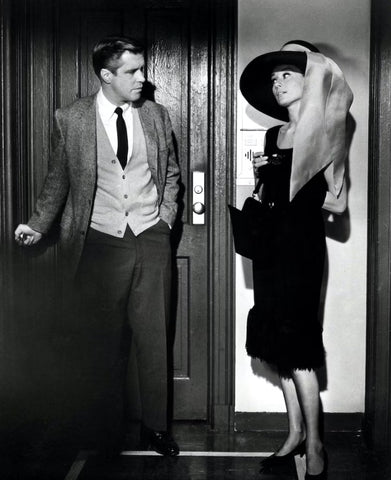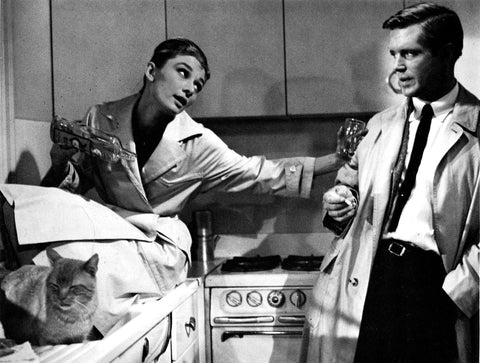Pandora Writer |
____________________
Audrey Hepburn, an enchanting presence on and off the silver screen, left her mark on the world of entertainment and beyond. Her grace, beauty, and genuine spirit endeared her to millions, making her a beloved icon for generations to come. Let’s look into the remarkable life of Audrey Hepburn, from her humble beginnings to her rise in Hollywood.

Audrey Kathleen Ruston was born on May 4, 1929, in Brussels, Belgium. Audrey hailed from a background where her father served as an English banker and her mother as a Dutch baroness. Her parents divorced when she was very young, and Audrey moved to the Netherlands with her mother.
Growing up during World War II, Audrey experienced the hardships of the time, including the German occupation. These early experiences shaped her into a compassionate and resilient individual. She would later attribute her thin figure to those wartime deprivations, but it was her spirit that truly defined her.
As Audrey grew, her love for dance became evident. She began studying ballet in Amsterdam and showed immense talent in this art form. Her passion and dedication led her to London, where she continued her training and eventually started performing as a chorus girl in various productions. This was the beginning of her journey into the world of entertainment, setting her on a path that would forever change her life.

Audrey's natural beauty and elegance soon caught the attention of the right people, leading her to the world of acting. Her debut on the West End stage in the play "Gigi" brought her to the notice of the film industry, leading to her first major film role in the 1951 British film "One Wild Oat." While this film didn't catapult her to stardom, it marked the beginning of a career that would soon see her grace some of the most iconic films in cinematic history.
Audrey's breakthrough in Hollywood came with her role in the 1953 film "Roman Holiday." Paired with Gregory Peck, Audrey's performance as Princess Ann, a royal seeking a taste of normal life, earned her an Academy Award for Best Actress.
Following the success of "Roman Holiday," Audrey continued to mesmerize audiences with a string of unforgettable performances. Her portrayal of the whimsical and fiercely independent Holly Golightly in "Breakfast at Tiffany's" (1961) remains one of her most iconic roles. Her exquisite style, epitomized by the little black dress and the timeless elegance she brought to the character, has become a symbol of both fashion and feminism.

Audrey's filmography includes a diverse range of roles that demonstrated her versatility as an actress. From the determined Eliza Doolittle in "My Fair Lady" (1964) to the empathetic Sabrina Fairchild in "Sabrina" (1954), she breathed life into each character, leaving a lasting impact on the world of cinema.
As the 1960s neared its end, Audrey transitioned away from acting to focus on her family life, only returning sporadically for select films during the 1970s and 1980s. The concluding years of her life were dedicated wholeheartedly to her work with UNICEF.
Beyond her on-screen success, Audrey Hepburn was also a dedicated humanitarian. Her experiences during the war deeply affected her and led her to become a Goodwill Ambassador for UNICEF. Through her work with the organization, Hepburn sought to improve the lives of children in impoverished countries and raise awareness about the importance of education and healthcare. Her visits to refugee camps, hospitals, and schools brought attention to the needs of those often forgotten by the world.

Shortly after assuming the role of a UNICEF Goodwill Ambassador, she embarked on a significant mission to Ethiopia, a country grappling with severe famine due to prolonged drought and internal conflicts. Over the subsequent years, Audrey embarked on numerous UNICEF field journeys.
Audrey's commitment to UNICEF was fervent and multifaceted. In recognition of her outstanding efforts, she was honored with the Presidential Medal of Freedom, the highest civilian distinction in the United States, in 1992. Despite battling cancer that year, Audrey persistently pursued her UNICEF work, journeying to France, Kenya, Somalia, Switzerland, the United Kingdom, and the United States.
Audrey Hepburn's life was tragically cut short by cancer on January 20, 1993, at the age of 63. She passed away at her residence in Switzerland.

Audrey's distinctive style, characterized by timeless elegance and simplicity, continues to inspire fashion trends today. She was a trendsetter, known for popularizing the little black dress and the iconic look in the film "Breakfast at Tiffany's." Audrey's grace, humility, and inner beauty made her a beloved figure, and her influence on popular culture remains profound.
Her commitment to giving back serves as a model for those seeking to make a positive impact on the world. Her quote, "As you grow older, you will discover that you have two hands, one for helping yourself, the other for helping others," reflects her philosophy of using one's platform for the betterment of humanity.
In an era when celebrity culture often revolves around scandal and excess, Audrey Hepburn's legacy shines as a beacon of humility, kindness, and compassion. Her life story reminds us that the true measure of greatness lies not in the number of awards received or records broken but in the hearts touched and lives changed for the better.
-----------------------------------------------------------------------------------------------------------
Did you know?

Audrey Hepburn experienced the hardships of World War II firsthand. She lived in the Netherlands, which was occupied by German forces during the war. She and her family had to endure food shortages and the difficulties of living in a war-torn country.
Before becoming an actress, Hepburn initially trained to become a ballet dancer. She studied ballet extensively in the Netherlands and later in London. Her ballet training contributed to her graceful presence on screen.
Audrey's first major success was in the Broadway play "Gigi," where she played the titular role. Her performance garnered critical acclaim and caught the attention of Hollywood.

One of Audrey's most iconic roles was as Holly Golightly in the film "Breakfast at Tiffany's." The film's glamorous fashion, Hepburn's portrayal of the quirky and charming character, and the memorable opening scene where she stands outside Tiffany & Co. in a black dress have become enduring symbols of classic cinema.
Audrey had a close professional relationship with the renowned fashion designer Hubert de Givenchy. Givenchy designed many of her iconic outfits both on and off-screen. The most famous collaboration was for "Breakfast at Tiffany's," where Givenchy created the elegant black dress Hepburn wore.

Audrey Hepburn won an Academy Award for Best Actress for her role in the film "Roman Holiday" (1953). This marked her first and only Oscar win.
Hepburn had two sons, Sean Ferrer and Luca Dotti. She took a break from her acting career to focus on raising her children.
In 1989, Audrey Hepburn was appointed as a UNICEF Special Ambassador, an honor given to those who continue to work for the organization after their initial appointment as a Goodwill Ambassador.
"I can testify to what UNICEF means to children, because I was among those who received food and medical relief after World War II. I have a long-lasting gratitude and trust for what UNICEF does." -- Audrey Hepburn

Audrey Hepburn is buried in the Tolochenaz Cemetery, located in Tolochenaz, a small village near Lausanne, Switzerland. She spent much of her later life in Switzerland and considered it her home.
"If my world were to cave in tomorrow, I would look back on all the pleasures, excitements and worthwhilenesses I have been lucky enough to have had. Not the sadness, not my miscarriages or my father leaving home, but the joy of everything else. It will have been enough." -- Audrey Hepburn
How Audrey Hepburn is connected to Dorothy Kilgallen? George Peppard (The A-Team) who played Paul in Breakfast at Tiffany's was close friends with Dorothy Kilgallen's older sister, Eleanor Kilgallen. Eleanor Kilgallen convinced George Peppard to take the role in the movie. Eleanor Kilgallen was a talent agent with clients from Warren Beatty to Kim Cattrall.








